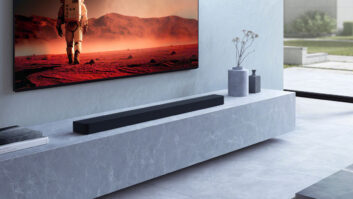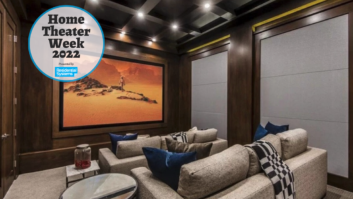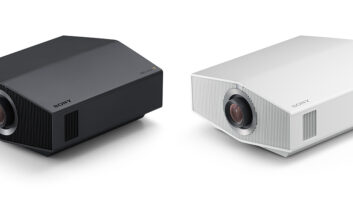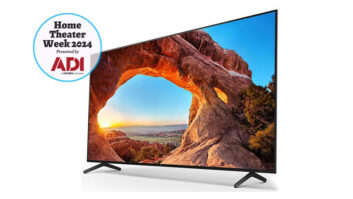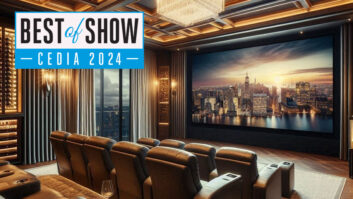
What do you call a surround system that isn’t a soundbar, a home-theater-in-a-box (HTIB), or a traditional receiver-based theater system? If you’re Sony, you call this genre-bending device the HT-A9 “High Performance Home Theater System.” (Even so, Sony is hedging its bets to make sure potential owners can find it by grouping the HT-A9 under the soundbar page on its websites.)
Sony introduced two new premium Dolby Atmos surround audio solutions last year at CEDIA 2021; the new flagship HT-A7000 soundbar and the new HT-A9 system.
According to Sony, the HT-A9 uses 360 Spatial Sound Mapping and, “by combing Sony’s unique ‘Monopole Synthesis’ and ‘Sound Field Optimization’ technologies, four speakers placed within a room create a soundfield equivalent to up to 12 speakers around the listener.”
Four speakers that create the sound of 12? A lofty goal for sure, but one I was keen on checking out.
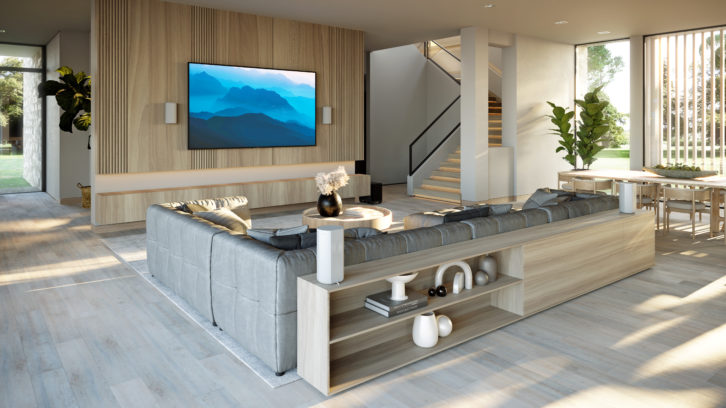
But beyond the potential sonic benefits of Spatial Sound Mapping, what the HT-A9 offers is a completely different look, design, and flexible installation that might make it a compelling alternative to a soundbar install.
Appearance
While not technically an HTIB, the HT-A9 does ship in a single box, and packed inside is the Control Box along with the four satellite speakers, a remote, and all necessary cabling.
The four satellite speakers are identical in appearance — a matte-white finish with micro-perf metal grille on the front and top with a cylindrical design standing a little over 12-inches. On first look, they reminded me of an outdoor weatherproof speaker. Since all of the speakers are self-amplified, they require power and come with detachable white power cords that connect to a channel at the bottom of the speaker. At six pounds, the speaker has decent heft and a rubber-footed bottom that shouldn’t damage anything it sits on.
With the vast majority of soundbars being black, the HT-A9’s white finish might be a selling point on its own. Or it might not. In cabinetry/bookshelves, it might be perfect, but others might not want white speakers if they are going around a black TV, though they would look slick mounted near a Samsung Frame TV with a white bezel….
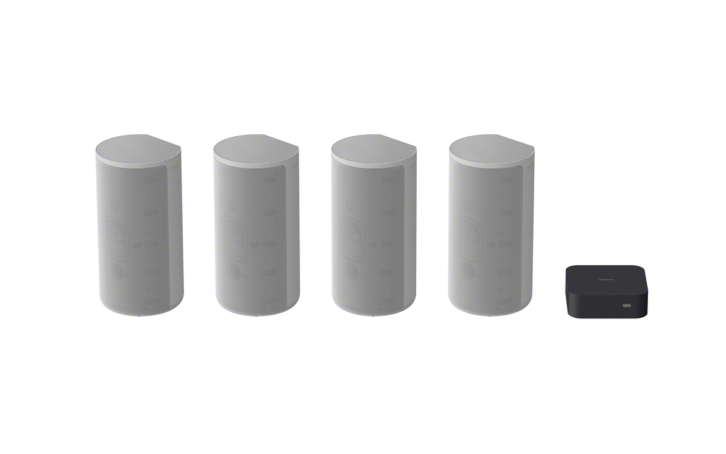
Each speaker packs three drivers in a tri-amplified design, totaling 12 drivers and 12 amp channels across the system. The front speaker section includes a 2 7/8- x 3 1/4-inch-wide directivity woofer along with a 3/4-inch soft dome tweeter, with a top positioned 1 13/16- x 2 1/4-inch upfiring speaker, with each speaker powered by independent 42-watt amplifiers. The front and top drivers utilize Sony’s new proprietary X-Balanced speaker units to achieve high SPL levels with low distortion.
Similar to Sony’s new HT-A7000 soundbar, the HT-A9 system is sold without a subwoofer and is described as a 4.0.4 system. For those wanting more low-end — and that will be most everyone — Sony offers two subwoofers that can pair with the HT-A9, the SA-SW3, and SA-SW5. For my review, Sony sent along an SA-SW5 for a full 4.1.4 surround system.
While the two optional subwoofers aren’t ugly, they aren’t going to win any visual design awards either. With the A9 speakers being white, some might prefer a matching color for the sub, however, both subs are finished in a dark charcoal grey with a pebbled finish and rounded corners and edges, with a grille cloth covering the front and back. With no buttons or controls for users to worry over, this is a set-it-and-forget-it device that will likely spend its days unobtrusively in a corner.
With the A9 selling for just under $2000 on its own, adding the SW5 subwoofer brings the system package to just a nick under $2700, placing it at the premium end of soundbar pricing. The HT-A9’s real “savings” compared to a traditional receiver-based system come in its flexible and far easier install.
Installation
With a soundbar, you’re limited as to where it can go, with the big decision being whether it will go on the wall or just sit on a tabletop. And if a customer wants a wall-mounted display without a soundbar marring the clean look, the HT-A9’s four satellites offer different installation and placement options that may be appealing.
With a TV centered between bookshelves, the HT-A9 will be a terrific option, giving the front speakers an obvious place to sit. Or with a TV perched on or above a piece of furniture, the speakers could sit on stands. Smartly, the back of the speaker is flat so it can sit snugly on a wall, and there is a removable tab on the back of all speakers that exposes a keyhole as well as a threaded insert for mounting. Of course, wall-mounting always poses its own set of challenges with a powered speaker.
While the speakers look identical, they are identified by FR, FL, RR, and RL underneath, and must be positioned as such.
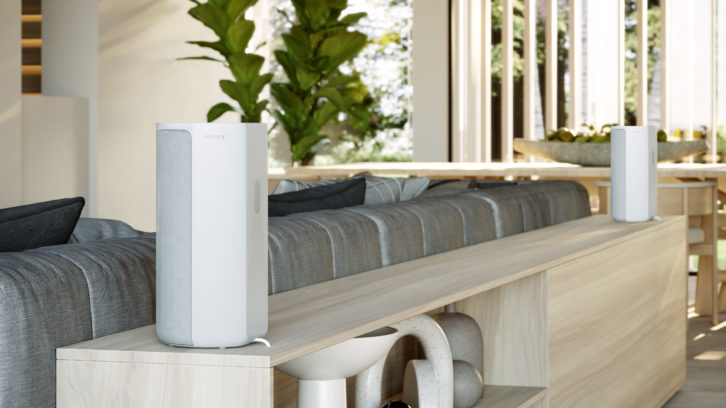
The Control Hub is a discreet 6- x 6- x 2-inch little black box where all connections and processing happens. The Hub features a small LED display and lacks any buttons. The Hub’s included remote is IR only, but when connected to the TV via eARC, control was seamless using the TV’s remote.
The Hub offers a single HDMI input along with an HDMI output that supports eARC, with both HDMI 2.1 connections supporting 8K and 4K/120 resolutions, along with Dolby Vision. And that’s it for source connections. Meaning there are no analog or optical audio inputs, so only newer TVs need apply to work with the A9. There is also an Ethernet connection and detachable power connection.
The Hub also features a mini-jack connection labeled “S-Center-Out.” Should you own a newer, BRAVIA XR-series Sony TV with a corresponding input, this is a simple plug-and-play connection via an included cable that will use the television’s speakers as the center channel.
Another benefit for Sony TV owners is a new integrated onscreen user interface when the TV and bar are connected via eARC. Here you can get quick onscreen access and control over key bar features within the TV’s GUI for things like rear and sub volume, changing sound modes, enabling voice or night mode, and so on. These features certainly make for tighter integration and are a strong argument for pairing the A9 with a Sony display.
Review: Sony XR65A80J OLED TV
Initial setup is straightforward and guided via the onscreen GUI. After all of the speakers and the Hub are connected to power, the first step is to optimize the wireless connection between them. This process takes about a minute, with a nice onscreen progress bar to let you know it is working. Next, you are prompted to run the Sound Field Optimization. Here a variety tones and chirps are emitted from each of the speakers’ front drivers and then height drivers with dual microphones in the speakers listening and then optimizing themselves. All of the speakers illuminate with a green LED (when active) to show they are paired, with a red LED when off. Should you have a speaker that doesn’t connect, there’s a simple process to manually link them. If the Ethernet isn’t connected, you’ll then connect to your network’s Wi-Fi, either 2.4 or 5 GHz.
After the initial setup, a new “Advanced Settings” tab appears that gives a deeper dive into the Hub’s setup, including Speaker, Audio, HDMI, Bluetooth, System, and Network settings, along with a prompt to check for software updates.
Similar to my criticisms with the HT-A7000 soundbar, I found the A9’s available audio adjustments to be very limited. There are some settings in the Sound Field Adjustment menu where you can tune the direction of the soundfield (selecting the TV position in relation to the front speakers and the seating position front-back and left-right to the speakers), height of soundfield, and sound from subwoofer with three distance options to the seating position, but there are no other ways to tweak the audio. While you can play test tones — cycling between the main channels, the height drivers, and sub — there are no levels to adjust here, so I guess it is little more than just a test to show all the speakers are actually functioning. (You can adjust the level of the rear speakers and subwoofer via the remote or integrated OSD with Sony TVs, but not while the test tones are playing.)
There is a Voice Up feature that increases dialog output, though this is just an Off or On setting, and I’d prefer at least a three-step “normal-medium-max.” There is also no ability to adjust the levels or effect of the height speakers.
Performance
As mentioned, the A9 system features a total of 12 drivers — four front-firing drivers, four front-firing tweeters, and four upfiring height drivers — driven by 126-watt amplifiers per speaker for a total of 504 watts.
I started off listening to the A9’s on their own without the subwoofer, and it quickly became apparent that the subwoofer is really needed for anything close to a cinematic experience. While the near-3-inch woofers delivered impressive bass for their size, they just couldn’t produce any true low-end. I couldn’t find any frequency response ratings, but the sound is definitely thin without the sub. For any serious listening, the sub should be considered a prerequisite.
After powering up the SA-SW5 subwoofer, it automatically created a link with the Hub and required no further effort on my part short of running the sound optimization again. (Interestingly, the subwoofer never emits any tones, meaning it doesn’t appear to be optimized in any way.) This SW5 features a 7.09-inch active driver with passive radiator powered by a 300-watt amplifier that energizes the air in a room enough to produce tactile bass frequencies you can actually feel. Without question, adding the subwoofer increased the performance and excitement of everything I watched, giving far more depth, range, punch, and dimension to the overall listening experience, making it sound far larger than just the four satellites.
As with my review of the HT-A7000 — which included a different SA-SW5 — I did notice some issues where the subwoofer could be overdriven into audible distortion or popping at higher volumes. This is especially noticeable when driven with lossless audio content from my Kaleidescape Strato.
What is immediately apparent is that the A9 speakers deliver actual width to the presentation, with the front left/right speakers placed wider than a bar could ever hope to be. There is no acoustic trickery necessary to place sounds wider than the screen because the sounds are actually coming from wider than the screen.
The wider front speaker placement also helps with the front-to-back cohesion, allowing the system to more easily create phantom images off to the sides of the listening area that makes the presentation feel bigger. The system does a really nice job of creating an enveloping bubble of sound around the listener.
With its four separate upfiring height speakers, I had high hopes that the A9 system could deliver an impressive Atmos experience, but I found that the A9’s struggled to deliver truly discrete “over-my-head” effects. The effect is more like a canopy of sounds happening up above. More like a layer of sounds above the screen height and less than pinpoint sounds directly overhead. Imagine being in a jungle and hearing kind of a general buzz of sounds that seems around and above you but not really focused.
I rewatched all of the familiar clips I know to deliver those big overhead height effects — the plane flyby at the beginning of Kong: Skull Island, Mysterio’s voice taunting Peter in Spider-Man: Far from Home, the probe droids whizzing past at the opening of The Empire Strikes Back, the first race from Ready Player One — and it was always more like just a higher soundfield and less sounds truly high overhead. On the few times when something did sound like it was overhead, like a PA announcement in Netflix’s The Man from Toronto, it was definitely an exception.
I know that upfiring speaker performance is impacted by the room and the height effect was more pronounced in my smaller listening room with a flat 9-foot ceiling as opposed to my larger living room, but this is the same room I’ve tested a dozen upfiring Atmos systems in, so I’m pretty familiar with how it can sound.
When most people think “soundbar,” they think of movies and not music, but the A9 is a really compelling music system with Google Chromecast built-in, as well as Spotify Connect, AirPlay2, and Bluetooth5.0. You can also stream content from a NAS drive using Sony’s Music Center app. With the speakers more widely placed than with a soundbar, the music presentation exceeds what a soundbar can deliver.
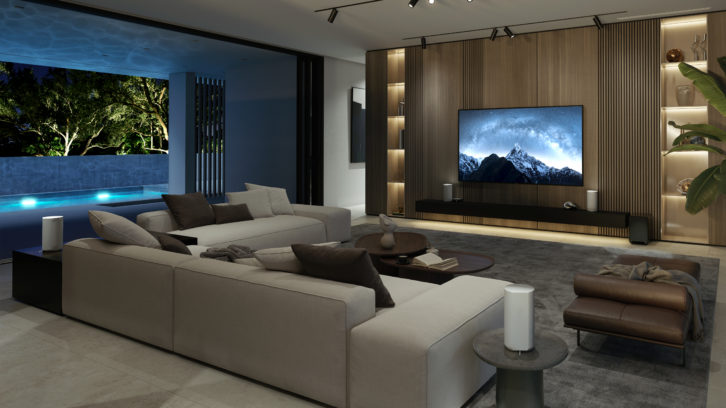
Sony has been making a push with its 360 Reality Audio, which they describe as “an audio format that uses Sony’s object-based spatial audio technology to deliver a full 360-degree audio experience.” The A9 system includes a coupon for a free three-month trial to the supporting streaming service of your choice, including Amazon Music HD, Deezer HiFi, Nugs.net, and Tidal. Using Tidal I was able to “360RAcast” music to the system and it almost always delivered an exciting, you-are-there, room-filling experience, especially on live performances.
Now, I’m generally a stickler for speaker location. Making sure I have my front left/right speakers optimally placed for stereo imaging, then placing the rear speakers off to the sides and slightly behind my seating location. And that is certainly how I started and did the majority of my listening with the A9’s.
But, as we know, perfect placement isn’t always possible in a customer’s home, and what makes the A9 so interesting and compelling is that the system almost encourages you to place the speakers wherever. According to Sony, you can place the speakers practically anywhere in the room — including at different heights and distances — and the optimization will “measure the position of each speaker to create the best sound for your room.” Further, the “ultra-wide listening area fills every part of your living space. Your family and friends get the same sound experience, wherever they are in the room.”
So, after my usual careful and optimal setup, I took a more willy-nilly approach. Front left speaker off to the size and several feet back of the TV, front right set at the middle of TV height and slightly ahead of the screen, surround right sitting on the floor off to the side and slightly ahead of my listening position, and the surround left wall mounted at ear height a few feet to the side of my seated position.
Even with this random and far-from-ideal speaker layout, the system delivered a convincing sonic image, providing the same big circular surround experience and even including a well-positioned and intelligible phantom center channel. Of course, this would be another strong argument for using the S-Center feature on compatible Sony TVs, where the center-channel dialog would be reproduced by the TV’s speaker.
To me, the A9’s layout flexibility might be its strongest selling feature; letting customers position speakers where they prefer instead of where they “must” go.
Having had the chance to audition both the HT-A7000 and the HT-A9 in the same room, I’m split on which I prefer. For movie watching, I felt the HT-A7000 delivered a more immersive and exciting experience, but for music listening the HT-A9 does a better job delivering a wider and less restrained front soundstage. The HT-A9’s big appeal is its flexibility in install location, and that it is offered in white. Just be sure and save some room in the budget to add the subwoofer, as it delivers a marked performance improvement.
877-865-7669; SONY.COM
Kudos: Incredibly flexible speaker positioning; simple setup; great for music listeners
Concerns: Overhead height effect not as impressive; pricey compared to other solutions
Product Specs:
- 0.4 Wireless Dolby Atmos Surround audio system
- 12 total drivers powered by 12 amplifier channels (504 watts)
- Decodes all major surround formats, including Dolby Atmos and DTS:X as well as hi-res audio up to 96/24 and 360 Reality Audio
- Google Chromecast built-in; also supports Spotify Connect, Apple AirPlay2, and Bluetooth5.0
- Ready for next-gen HDMI formats including 8K and 4K/120
- 11 a/b/g/n/ac Wi-Fi
- Supports voice control via Amazon Alexa and Google Assistant
- Inputs: HDMI 2.1/HDCP 2.2 inputs (8K and 4K/120 capable), USB (updates), Ethernet; Outputs: HDMI 2.1/HDCP 2.2 (8K and 4K/120) with eARC, mini-jack S-Center Out; detachable 12-volt power plug
Dimensions:
- HT-A9 Satellites: 6 3/8 x 12 3/8 x 5 7/8-inches (WxHxD); Weight: 6 pounds
- SA-SW5 Sub: 10.9 x 16.1 x 16.61 inches (WxHxD); Weight: 28.66 pounds

